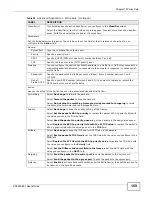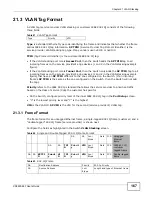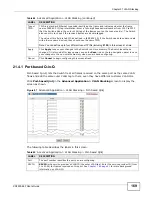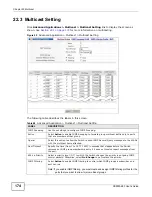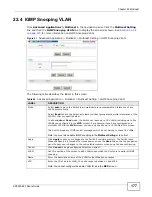
XS3900-48F User’s Guide
165
C
H A P T E R
2 1
VLAN Stacking
This chapter shows you how to configure VLAN stacking on your Switch. See the chapter on VLANs
for more background information on Virtual LAN.
21.1 VLAN Stacking Overview
A service provider can use VLAN stacking to allow it to distinguish multiple customers VLANs, even
those with the same (customer-assigned) VLAN ID, within its network.
Use VLAN stacking to add an outer VLAN tag to the inner IEEE 802.1Q tagged frames that enter the
network. By tagging the tagged frames (“double-tagged” frames), the service provider can manage
up to 4,094 VLAN groups with each group containing up to 4,094 customer VLANs. This allows a
service provider to provide different service, based on specific VLANs, for many different
customers.
A service provider’s customers may require a range of VLANs to handle multiple applications. A
service provider’s customers can assign their own inner VLAN tags on ports for these applications.
The service provider can assign an outer VLAN tag for each customer. Therefore, there is no VLAN
tag overlap among customers, so traffic from different customers is kept separate.
21.1.1 VLAN Stacking Example
In the following example figure, both A and B are Service Provider’s Network (SPN) customers with
VPN tunnels between their head offices and branch offices respectively. Both have an identical VLAN
tag for their VLAN group. The service provider can separate these two VLANs within its network by
Summary of Contents for XS-3900-48F
Page 15: ...15 PART I User s Guide ...
Page 16: ...16 ...
Page 48: ...Chapter 2 Tutorials XS3900 48F User s Guide 48 ...
Page 62: ...Chapter 4 The Web Configurator XS3900 48F User s Guide 62 ...
Page 63: ...63 PART II Technical Reference ...
Page 64: ...64 ...
Page 227: ...Chapter 26 VLAN Mapping XS3900 48F User s Guide 227 ...
Page 320: ...Appendix A Common Services XS3900 48F User s Guide 320 ...
Page 332: ...Index XS3900 48F User s Guide 332 ...









